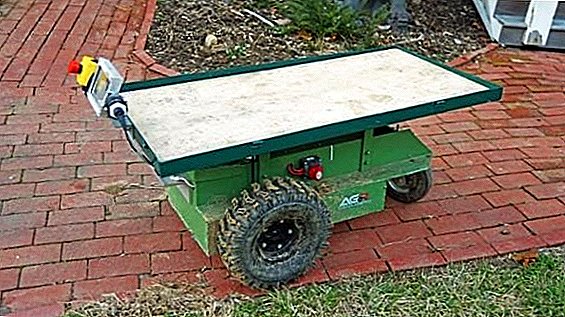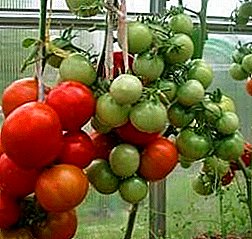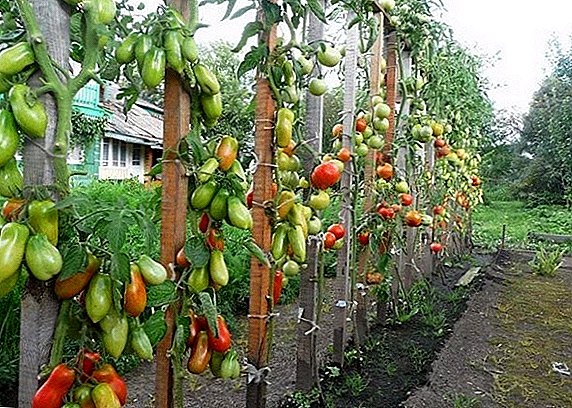
Practically all farmers engaged in growing various crops on their garden plots always allocate a bed for a traditional vegetable - tomatoes. This is not surprising, because growing these fruits independently is extremely interesting. Varieties are very different - both stunted and tall. In our area planting is dominated by tall tomato crops, which give large fruits. Although they require a certain amount of time to care for themselves, the result will always be worth it. Not the last value in the cultivation of tomatoes is their garter. Further in the article we will learn how to properly tie up tall tomatoes planted in the open field, and we will also figure out what, in fact, they need to be tied up.
Why do this?
No matter how strong the stalk of this plant may be, experienced gardeners still strongly recommend tying up tomatoes. Almost all tomato varieties require such manipulations, and garter for tall tomatoes is especially importantwhich often reach a height of 2 m.
Check out the characteristics of these tomato varieties: Siberian Early, Shuttle, Sugar Bison, Honey Drop, Cardinal, Verlioka, Gigolo, Pink Paradise, Golden Heart, Red red "," Rapunzel "," Honey saved. "
As for low-growing tomato varieties, they don’t need a garter, by and large. But such varieties are used by gardeners less and less, because everyone tries to use the area of his plot as efficiently as possible, and tall tomatoes are more cost-effective compared to low varieties.

Tomato garter is an extremely important procedure. It performs many useful functions:
- Tomato stalks do not break during the growth period, as well as under the weight of juicy fruits. Culture forces are spent not on survival, but on ensuring good yields.
- The bush, which is located vertically, is open to the sun and fresh air, which favorably affects its development and fecundity.
- Rain will not be able to harm the culture that is planted in the open. If the tomato plant is positioned vertically, then the green part and the fruits will not rot in the overwetted soil.
- A plant that has passed the garter is easier to spray.
- It is also easier to conduct other procedures for the care, in particular, to mulch and spud plants, weed the soil.
- It is known that when watering tomatoes it is recommended to avoid moisture on the deciduous part of the plant. Thanks to the garter to fulfill such a requirement will not be difficult.
- Thanks to the garter, the fruits are placed high enough above the ground, which will protect them from being hit by slugs and mice.

Based on all of the above, there should be no doubt about the need for a garter of tomatoes. It is recommended to build garters for about 15-20 days after the seedlings are planted in the place of permanent growth. Methods of garters tomatoes planted in the open field, are different. Next, we consider the most common of them.
Ways
The development of gardening does not stand still. Breeders regularly submit to the general attention of all new varieties of vegetable crops. Also, farmers know many ways of tying tomatoes at the site. The effectiveness of many has been confirmed by practice, so that a novice gardener can choose almost any of them.
Important steps in the cultivation of tomatoes are pasynkovanie and plant nutrition.
On pegs
This is the most popular way to help maintain the vertical position of the stems of a tomato culture. To implement it, you should drive a peg next to the plant into the soil, and then carefully attach the stem to it. If necessary, the garter should be made in several places. Stake height should be about 20 cm above the tomato stem.  Tie the stem to the peg can be any pieces of fabric. But it is better to choose a synthetic material, since natural fabric will rot and thereby damage the plant.
Tie the stem to the peg can be any pieces of fabric. But it is better to choose a synthetic material, since natural fabric will rot and thereby damage the plant.
Important! It is not recommended to tie the tomatoes with a tight rope or wire, since they cut into the stem of the plant and harm its development and growth.It is also recommended to pre-boil the material, which will be held garter. So you can avoid infection by parasites. Also in specialized stores sold "clamps", which are designed to secure tomatoes, they can also be used.
The garter itself should be made as high as possible, while the harness should not be tightly tightened, as tomatoes can simply die. As the tomato crop grows, the garter can be gradually moved up or removed and tied up again.

On the trellis
If there are a lot of tomatoes planted in the open field, then the garter using the peg method can be inconvenient to use. It is better in this case to tie up the plants on the trellis.
You need strong stakes and a thin long bar. Pegs will need to drive in the opposite sides of the beds, and between the stakes to stretch and secure the wire. Bind plants should be directly to the wire. This method can be used in several variations:
- Stretch a strong wire between high bars at a height of about 2 m and use long strings that will reach both the stem and the wire. The stalks of tomatoes will grow and twist these twines as they develop.
- Stretch a few wire rows, also securing them on the pegs. At the same time, each individual tomato bush will need to be tied several times to the stretch, or else the lashes as they grow through the horizontal strips, forming a kind of tomato wicker.

Important! On a long bed the design can be improved, having made it stronger. To do this, drive a few extra pegs between the two main ones. In this case, even a strong wind can not damage the garter.
Cages for vegetables
Also, gardeners can build cells for their tomatoes. Such designs will fold more than one season. It will be necessary to make cages separately for each bush of tomatoes.
Using a dense and rigid wire, you need to form several of the same size circles. Then they should be fastened together, keeping distance, using a vertical rack, which can also be made of wire. The result should be some kind of cylindrical cells. Such constructions need to be placed on a bed over tomato bushes and, as the plant grows, make a garter.
If it is not possible to find the required wire density, then the cage can be made of wood. You can also make the structure wider, then it will be able to cover not one bush, but several at once. This adaptation will be much more reliable than ordinary pegs. 
Did you know? Like many other cultures that were new to American colonists, tomato was considered poisonous and deadly for a long time. This opinion was maintained until 1820. The attitude to this culture changed only after Colonel R.G. Johnson used a bucket of tomatoes in the square near the courthouse in Salem, New Jersey. The crowd watched in amazement at this process and made sure that it was obviously impossible to die from eating tomatoes.
Caps
To carry out the garter of tomatoes planted in open ground, you can also use a kind of caps. This method, by the way, is suitable for garters and other plant crops.
 For the manufacture of such a device will need branches of the rod or wire. You need to make a kind of pyramid with the base and cross-viscous in shape of the cell. Such caps should be installed on the bed during planting, at a distance of about 1 m from each other. If the plot allows, the distance may be even greater, this will avoid unnecessary crowding of tomatoes.
For the manufacture of such a device will need branches of the rod or wire. You need to make a kind of pyramid with the base and cross-viscous in shape of the cell. Such caps should be installed on the bed during planting, at a distance of about 1 m from each other. If the plot allows, the distance may be even greater, this will avoid unnecessary crowding of tomatoes.
Did you know? At present, at least 10,000 different varieties of tomatoes are known. The largest tomato can reach a weight of about 1.5 kg, and the smallest has a diameter of not more than 2 cm.
Tips and tricks
Even an aspiring gardener will be able to carry out the garter, because this procedure does not cause any particular difficulties:
- Experienced farmers recommend annually using new material to tie the stems to the base, as old tissue patches can provoke various kinds of diseases.
- It is also recommended to pre-disinfect all inventory that will be used. It is necessary at least to boil the twine that will be in direct contact with the plants.
- It is extremely important to conduct all manipulations without haste and with care so as not to damage the tomatoes. You can not overtighten the stems too much, otherwise the plant may begin to die.












